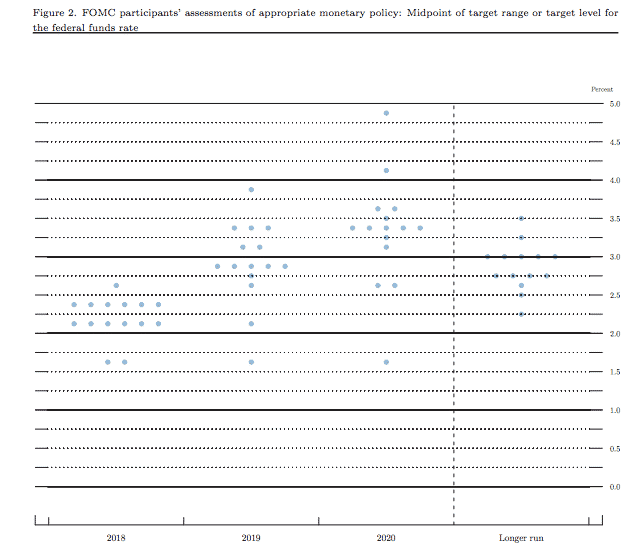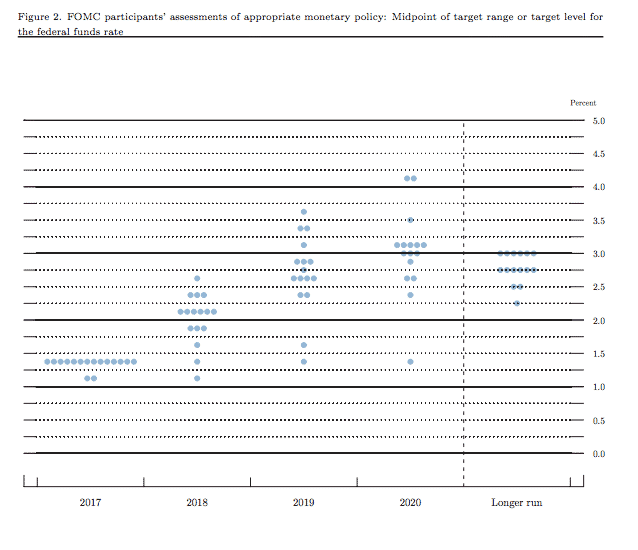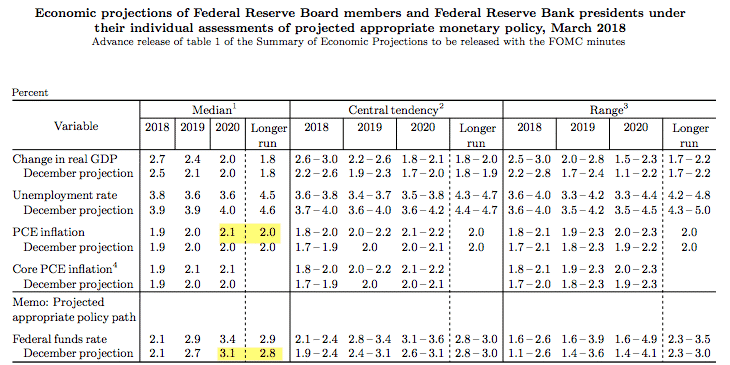Jerome Powell affirms Fed commitment to rate hikes through 2020
Yesterday the Federal Reserve’s Federal Open Market Committee decided to raise the target range for the federal funds rate to 1-1/2 to 1-3/4 percent. That’s a quarter percent increase from prior levels.
But the real story of the Fed’s decision was in its forward guidance because it revealed that the Fed is more hawkish now than it had been when Janet Yellen was still heading the Fed. The new Fed chairman Jerome Powell has struck a more upbeat tone about the US economy. And interest rates are likely to rise at a faster pace as a result.
Below is my analysis of the key takeaways from the FOMC statement and projections and Jay Powell’s press conference after their release.
The Dot Plot: Fed projections through 2020
When asked about the Fed’s balance sheet, Fed Chairman Powell explained that he sees the Fed’s control of interest rate policy as the primary tool in the Fed’s arsenal. In effect, he was telling markets not to focus on the Fed’s quantitative tightening operation. Instead, he is telling us to focus on what the Fed does with interest rates.
As such, the Fed’s forward guidance takes on particular significance. And amongst the Fed’s projections for forward guidance is a dot plot — a chart showing the federal funds rates that Fed officials believe are appropriate for the Fed’s projected future economic conditions. That’s the tool we need to zero in on.
Here’s what the Dot Plot looked like yesterday.

And here’s what it looked like in December under Janet Yellen.

Source: Federal Reserve
The chart is showing that Fed officials have increased the interest rate they believe will be appropriate for economic conditions in 2018, 2019 and 2020.
- For 2018, the numbers reveal a median estimate of 3 quarter-percentage rate increases
- For 2019, the Fed projects three more quarter-percentage rate hikes
- And in 2020, Fed officials are estimating that economic conditions will warrant two more rate hikes still
That’s a total of 7 more rate increases from here through the end of 2020, after the next Presidential election.
Look at the 2018 dots first. In December, the increase is notable. We have gone from 9 of 15 estimates between 2 and 2.5% to 12. And more of those estimates are saying 2.25-2.50%, or 4 rate increases in 2018.
Jerome Powell: Aggressive Fed projections beyond 2018
Now, back when Jerome Powell gave his first statements to Congress, I noted the following:
We shouldn’t expect a deviation from the Fed’s stated policy path. That calls for three rate hikes in 2018. And this is where market speculation has been most acute. But given Powell’s hawkish tone, we should look for two things from the Fed going forward.
First, we should look at how Powell reacts to any increase in inflation. The Taylor Rule suggests the Fed is behind the curve. If Powell supports that rule and inflation rose, he would signal comfort with moving to four rate hikes in 2018.
Second, we should also look at what Powell signals about policy beyond 2018. So far, markets have been focused on the three rate hikes for 2018. But Powell’s remarks yesterday show someone prepared to keep the Fed’s rate hike train going far beyond 2018.
After the FOMC statement, I still believe all of that is true. But more than that, the dot plot now confirms that it’s beyond 2018 where the real hawkishness comes into play. Powell specifically downplayed the internal consistency of the Fed’s projections when asked about them. But if you look at the Fed’s projections, not only are rates higher than in December, they are much higher than the so-called neutral rate.

Source: Federal Reserve
The Fed was saying we would get to 3.1% just after the Presidential election, where the neutral rate was 2.8%. That’s an overshoot of 30 basis points. Now, the Fed is saying the neutral rate is 2.9% but that we will be 50 basis points above.
In essence, the Fed is now 30 basis points more aggressive than it was in December. And it is 20 basis points more aggressive relative to the ‘neutral rate’.
How to parse the rationale for the Fed’s projections
I think Powell is right. The numbers for 2019 and 2020 really aren’t a great guide. You can’t predict that far in advance using standard econometrics. If only we could!
Nevertheless, if you look at the change in the numbers from December to March, you can see why the Fed is more hawkish. GDP is up, the unemployment rate is down and inflation is up relative to December. The big tell is unemployment. 3.6% by the end of 2020 is almost a full percentage point below the ‘neutral rate’ of 4.5%. That’s a huge undershoot.
So, while the numbers themselves may be guesswork, they are revealing about Fed thinking. On average, Fed officials believe that the US economy will be running so hot by 2020 that the unemployment rate will be almost a full percentage point below its non-accelerating inflation rate of unemployment (NAIRU). That’s the level at which inflation is supposed to accelerate. Those projections practically mandate a more hawkish stance.
Going forward, I expect to see the following:
- the median dot rise to four hikes in 2018 if inflation surprises to the upside.
- the neutral rate of unemployment crawl down if inflation doesn’t rise
- the neutral and projected fed funds rates rise if real GDP growth surprises to the upside
Downside surprises will have to be relatively large to see any of these changes move the other way. That’s because the unemployment rate is already below the Fed’s neutral rate. Inflation is the controlling variable from here on out. If inflation stays muted, the Fed will stick to its timetable. If it rises, projections for the fed funds rate will rise too.
Two rate hikes are effectively off the table for 2018 as a likely outcome. Four rate hikes will become guidance if inflation rises. And beyond 2018, expect the dots to move up before they move down.
Comments are closed.